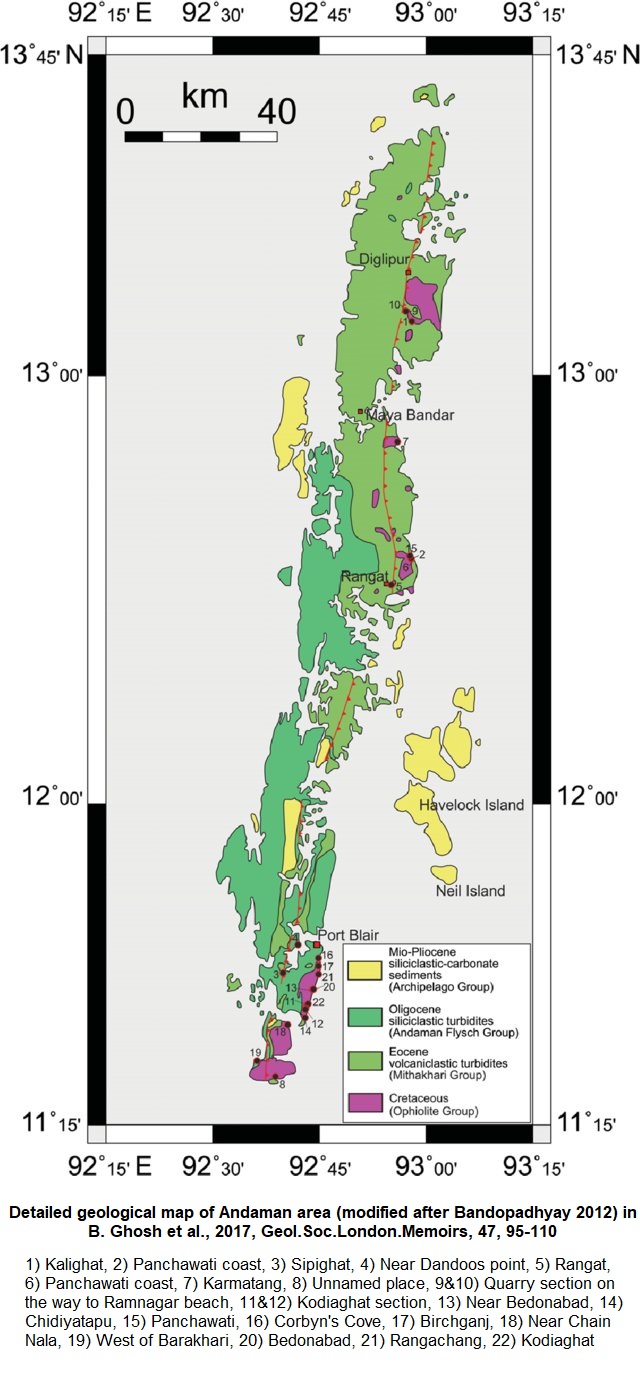Saddle Hill Fm
Type Locality and Naming
Named after Saddle Hill range of North Andaman, which is the type section. In the Middle Andaman Islands, all the members of Baratang Fm are intruded by basic and ultrabasic intrusive. In other islands also, such intrusives are seen in the undifferentiated Baratangs. The rocks were called ‘Ultrabasics’ by Chandra et al (1961) who later termed them as Igneous Series. Shrivastava et al., (1974), formally named this unit as ‘Saddle Hill Group’ after Saddle hill range of North Andaman, the highest topographic feature in Andaman Islands (600m). The Saddle hill was designated as type area of the Group. This Group was subdivided into ‘Panchavati’ Ultrabasic Formation after Panchvati Hill in Middle Andaman. Following the Code of Stratigraphic Nomenclature, the Saddle Hill Group and Panchvati Formation of Shrivastava et al., (1974) are included here in Saddle Hill Formation. This formation includes all the basic and ultrabasic intrusives in Baratang Fm (Pandey and Dave, 1998).
[Original Publication: Shrivatsava, J.P., Bansal, S.S. and Gadkari, S.D. (1974) Geology of parts of Middle Andaman Island, Progress report of Geological party No.16, Field season 1972-73, ONGC, Directorate of Geology.].
Lithology and Thickness
Igneous intrusions. The main rock type of Saddle Hill Formation are coarsely crystalline ultrabasic rock, serpentinized and rarely volcanic rock. The ultrabasic rocks comprise of dunite, peridotite, pyroxenite, gabbro etc. and are dark greenish grey to black in appearance (Shrivastava et al., 1974). The rocks in general are highly weathered, occasionally sheared and mostly serpentinized. At places, thin fibrous asbestos is observed along fissures and fractures.
Relationships and Distribution
Lower contact
Intrusive: The ultrabasic rocks are found as intrusive in Baratang Fm. In Middle Andaman, they intrude all the five members of Fm Formation viz. Karmatang Sandstone, Kalsi Shale, Lipa Sandstone, Neali Alternation and Burma Dera Members. The intensity of intrusions decreases in the younger sequences.
Upper contact
Higher up in the Port Blair Fm, the intrusives are absent.
Regional extent
In the Middle Andaman Islands, all the members of Baratang Fm are intruded by basic and ultrabasic intrusive. The intrusive occur mainly as stock like bodies or small plutons forming topographic highs e.g., Mt. Ferrington, Beehive Hill, Dashtratpur, East Rangat, West of Porlob Island. They are also known from a number of places in Middle and South Andaman including areas north and south of CuthBerts Bay, Jhinga Nala, Pitchar Nala, Bakultala etc. in Middle Andaman and near Cheriya Tapu in South Andaman. On the eastern side of Panchvati, Shrivastava et al. (1974) observed alteration of Peridotite/Dunite to Serpentines. The beach sands adjoining the Panchavati ultrabasics contain magnetite, hematite and probably chromite which seem to have been derived from the serpentinization of ultrabasics. In Parnasala nala, a small outcrop of volcanic rocks is noted. Calcisilicate rocks also occur, as small outcrop, in the proximity of bigger igneous bodies. The association of ultrabasics and volcanics-the ophiolites are widely recoded from geosynclines. In Baratangs, the effect of intrusions on the sediments is noticeable in Middle Andaman. Due to intrusion, the sandstones have become quartizitic, shales have become phylitic and at places, assimilation and xenoliths of older rocks are also seen within intrusives (Pandey and Dave, 1998)
[Figure 1: Detailed geological map of Andaman area (modified after Bandopadhyay 2012) showing locations mentioned in numbers in B. Ghosh et al., 2017, Geo.Soc.London.Memoirs, 47, 95-110)]
GeoJSON
Fossils
Age
Depositional setting
Additional Information
